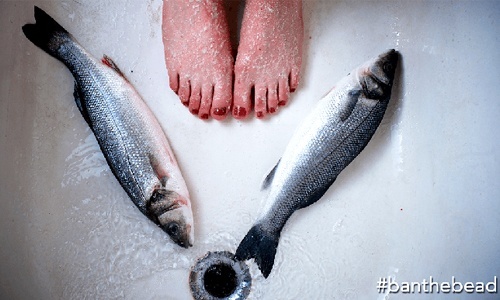

The one place we won’t negotiate? Safety. Whatever reformulation personal care product companies choose has to be proven safe for the environment. And until we’re able to prove, beyond a shadow of a doubt, that their preferred alternatives are safe, we’re not willing to take the word of the very same companies that have been polluting our waters for over a decade with 2.9 trillion particles of plastic annually. So, to all you journalists out there—the media characterization of Johnson & Johnson and Procter & Gamble agreeing to “voluntarily phase out plastic microbeads” is totally incorrect. They have agreed to phase out polyethylene microbeads and that’s it—they have no intention of using anything other than a new type of plastic.
So What are They Going to Use?
For two years we’ve been asking personal care products companies to tell us what ingredient they were looking to reformulate with. Only weeks ago did they disclose it—a type of plastic called Polyhydroxyalknoates (PHAs). What’s interesting is that PHAs have been commercially available for over a decade for use in personal care products. There is nothing innovative about it; these same companies chose not to use PHAs because it’s more expensive—legally, they could be using it right now. They chose to pollute instead of spend a few bucks on making their products safer.
To be fair, PHA is truly a great technology and I’ve learned tremendous amount about it the past year (yes, we anticipated what they’d use)—it has similar performance attributes to polypropylene and is fully biodegradable in the environment. Starbucks should be lining their paper cups with it. Keurig should be making coffee pods out of it. Both applications would be backyard compostable. Biodegradation times will vary in different temperatures and availability of microorganisms to eat it, but as a compound, it’s not dangerous and doesn’t require an industrial composting facility to degrade.
Most likely, PHAs would be an okay alternative (a dumb application of a promising technology) as it readily enters the Earth’s natural carbon cycle. Fish can eat it and digest it. Could plankton be adversely affected, due to their small size? Would it choke coral? Answer—we don’t know, scientifically. Nature itself even produces PHAs as a carbon storage device—translation, microorganisms make a sack lunch to eat later. The biggest drawbacks of PHAs are that they’re typically made from corn, palm oil, canola oil and sugarcane as a feedstock.
If those crops aren’t cultivated sustainably, they have a whole other suite of adverse affect on the ocean—pesticides, nutrients causing hypoxia, etc. But what could make PHA, by itself, dangerous? Adding a bunch of toxic and persistent additives to formulations that remain in the environment, even after the plastic has degraded. Most plastics have additives in them to give them their performance attributes. We are not going to trust Johnson & Johnson and Procter & Gamble that they’re going to use PHAs and not mix it with other bad stuff. What’s the saying? Fool me once, shame on you, fool me twice, shame on me.
As an act of good will, we even publicly committed to crafting a policy that will assess the safety of proposed ingredients and at the same time jump start innovation and green jobs. We created a mechanism in our bill for a California agency to assess proposed ingredients for safety and biodegradability claims. Johnson & Johnson and Procter & Gamble opposed that, too, wagering they could just kill the bill entirely. So we passed it without, simply banning plastic microbeads.
You know who didn’t oppose the agency oversight mechanism? Mango Materials—a California based producer of PHAs whose technology is so advanced, they don’t need to mix their materials with persistent compounds to achieve desired performance attributes. And heck, they even make it from a feedstock of waste methane, sequestering a potent greenhouse gas. So what is Johnson & Johnson and Procter & Gamble hiding? Or are they just really bad at communicating from HQ to their hired lobby guns?
But beyond all the fighting in state and federal capitals, Johnson & Johnson and Procter & Gamble are just plain missing the point. One, we don’t need exfoliants at all. They serve no medicinal purpose—to wit, even Johnson & Johnson compare their products’ efficacy to a sponge on their own website. Please let’s bring back the sponge. Or the loofa. Even the natural stuff is packaged in plastic. But the bigger point is simpler, regardless of the environmental implications—people don’t like washing their face and brushing their teeth with plastic, biodegradable or otherwise. It’s time for these companies to quit fighting us, acknowledge they were wrong to put little bits of plastic in their products and retool their product lines to be safe. You earn trust.
YOU MIGHT ALSO LIKE
9 Fortune 500 Companies Pledge to Go 100% Renewable
IKEA: Going 100% Renewable by 2020 Makes Good Business Sense

 233k
233k  41k
41k  Subscribe
Subscribe 